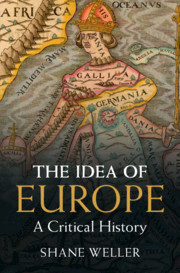Book contents
- The Idea of Europe
- The Idea of Europe
- Copyright page
- Contents
- Acknowledgments
- Introduction
- Chapter 1 Myths of Europa: From Classical Antiquity to the Enlightenment
- Chapter 2 A Great Republic of Cultivated Minds: 1712–1815
- Chapter 3 Nationalism and Universalism: 1815–1848
- Chapter 4 The Russia Question
- Chapter 5 Homo Europaeus: 1848–1918
- Chapter 6 The European Spirit: 1918–1933
- Chapter 7 A New European Order: 1933–1945
- Chapter 8 Unity in Diversity: 1945–1989
- Chapter 9 Other Europes
- Chapter 10 Europe against Itself: 1989 to the Present Day
- Conclusion Good Europeans?
- Notes
- Bibliography
- Index
Chapter 10 - Europe against Itself: 1989 to the Present Day
Published online by Cambridge University Press: 14 May 2021
- The Idea of Europe
- The Idea of Europe
- Copyright page
- Contents
- Acknowledgments
- Introduction
- Chapter 1 Myths of Europa: From Classical Antiquity to the Enlightenment
- Chapter 2 A Great Republic of Cultivated Minds: 1712–1815
- Chapter 3 Nationalism and Universalism: 1815–1848
- Chapter 4 The Russia Question
- Chapter 5 Homo Europaeus: 1848–1918
- Chapter 6 The European Spirit: 1918–1933
- Chapter 7 A New European Order: 1933–1945
- Chapter 8 Unity in Diversity: 1945–1989
- Chapter 9 Other Europes
- Chapter 10 Europe against Itself: 1989 to the Present Day
- Conclusion Good Europeans?
- Notes
- Bibliography
- Index
Summary
The liberation of Eastern Europe from Soviet control in 1989, followed by the reunification of Germany in 1990 and the establishment of the European Union at the Maastricht Treaty in 1992, seemed to many Europeans to be the realization of the long-held dream of a Europe that was finally at one with itself. In the following decades, EU membership grew from twelve to twenty-eight, embracing many Central and Eastern European countries. In 1993, the European Union member states agreed on the “Copenhagen criteria” to determine the eligibility of nations to join the Union. There were, however, also growing pressures, with a renascent nationalism that culminated in the departure of the UK from the EU in 2020. Chapter 10 focuses on the ways in which the EU came increasingly to be seen as failing to embody the true spirit of Europe, the critique coming both from those who championed national cultures as well as from those who, while feeling that there was a “democratic deficit,” wished to see a reformed EU. The chapter considers a wide range of contemporary views from thinkers and writers across Europe, including Hans Magnus Enzensberger, Umberto Eco, Jürgen Habermas, Régis Debray, and Leili Slimani.
- Type
- Chapter
- Information
- The Idea of EuropeA Critical History, pp. 247 - 268Publisher: Cambridge University PressPrint publication year: 2021



